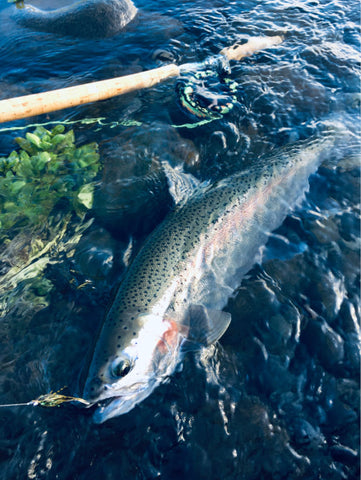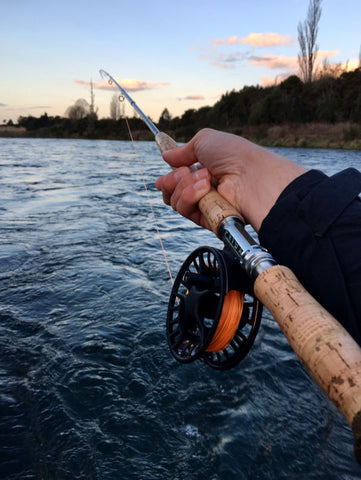6 tips to improve your Two Handed Fishing | Ollie Bassett
Two hand fly fishing is extremely popular these days. Spey, streamer, swinging, whatever you call it or your style, here are six tips to help get your net wet.
Even though I’ve been fishing with two handed rods since 2018, it's really only been over the past couple of winters that I’ve become successful with them. In fact to start with I couldn’t catch a fish with my two handed set up to save myself. My total lack of success was due to a few different reasons that might sound familiar to some of you.

To start with, my idea of how to fish with two handed rods was shaped by watching videos from the Pacific Northwest of guys catching Steelhead and Salmon. Although these videos are super cool and are great for getting gee’d up about swinging flies, a lot of the ways they fish are very different to what works here in New Zealand. I also got super into tying big and colourful intruders, forgetting that our winter fish come from lakes and don’t eat shrimp, big baitfish and squid in an ocean like Steelhead do. I was also using a 13’ 6 wt, which, although fun to cast, was massively overpowered for the Taupo rivers, and caused me to lose many of the few fish I hooked.

It wasn’t until I scaled down my two handed set up to a 11’ 4 wt Primal Run and started fishing the fly (rather than casting as far as I could) that I started to catch fish. Focusing on presenting the fly as effectively as possible is vital in all aspects of fly fishing whether it be dry fly, euro nymphing or spey style fly fishing. Where I was going wrong with swinging flies seems pretty obvious in hindsight, but these new styles of fishing can seem confusing and make it easy to miss these basic principles that are key to success (as I did).
Below are six tips and tricks that helped me start catching more fish and enjoying fishing with my two handed set ups in the winter months that will hopefully be helpful if you are getting started with this cool way of fly fishing.
6 Tips for Two Handed fishing
1 - Target specific areas rather than always casting to the far bank
Short casts may not look as cool, but in most situations will catch you more fish than bombing long casts all the way across the river. When swinging flies in the winter I look for areas that fish like to hold in that I can target effectively such as deeper guts, seams between faster and slower water and the tail outs of pools. By casting shorter and more effectively covering the right areas you will improve your chances of catching fish.
2 - Get your fly swinging slow and deep
The angle at which you cast across the river helps dictate the depth at which your fly fishes as it decides the amount of time your fly and tip have to sink before tension is established - i.e. if you cast down and across you will get less deep than if you cast up above yourself. Thinking about where to place the cast based on the depth of the lie you are fishing is key for success.

3 - Mend your line
Mending is critical when swinging with a two handed rod as it helps get your fly to the desired depth. If I’m fishing a deeper area I like to cast further above myself and mend the back of the Skagit head upstream and then hold my arm out with the rod high so I can follow the set up down as it sinks. Once I feel the line set downstream I slow the swing right down by following the line very slowly around as it swings with the rod tip.
On the other hand, if I am fishing in a shallower tail out I may cast down and across and let the fly swing with my rod tip held closer to the bank. This speeds the swing up a little and keeps the fly off the bottom which can be beneficial in these scenarios. One other option is to cast across and mend the back of the Skagit head downstream so that the line lies more across the river as it swings. This leads to the fly swinging more broadside rather than tail first from the perspective of the fish and can be worth a try if the fish are more aggressive and are responding to a faster swing.
4 - Dial in the fly
Even though many big bright intruder flies look super cool and catch the angler, it's often better to fish the smaller more boring looking flies that the fish seem to prefer. My favourite flies for swinging with a two handed rod are basically smaller dull woolly buggers tied with stinger hooks in the tail. I have also done well with slim rabbit flies tied in a similar fashion. I like to vary the weight of the fly based on how I want the fly to fish - in deeper water I may use a heavily weighted one with a 4mm bead, whereas in slow shallow tail outs unweighted flies are a better choice as they snag up less on the bottom.
I have also had some success with tube flies, but again I have had better success on the more natural (boring) patterns rather than bigger brighter ones that may work better for Steelhead than trout. In dirty water, big bright flies do have their place, but in most clear water conditions it's better to use something more dull and sparse. Another thing that's absolutely key is to keep the hooks sticky sharp, either with a small file or by switching the hook out. This makes a lot of those half hearted grabs stick and is another reason I prefer flies tied in a stinger or tube style as this allows me to swap out dull hooks.

5 - Choose the right setup
Since switching to a shorter and lighter two handed rod I have found this style of fishing much more enjoyable. Many anglers are now using short switch rods in the 3/4wt category rather than the big 6/7wts that were initially available as imports from the American steelhead market. I like to match my 11’ 4 wt Primal Run with a 300 grain floating Skagit head (although sinking options can be useful in some scenarios), with around 10 - 12 ft of T8 sink tip. Off the end of this I use between 2 - 6 ft of 12 pound tippet (the takes are often hard and fast) and a fly of varying weight depending on the depth. I find with this setup I can effectively fish the smaller and bigger spots on the TT and Tongariro without having to switch the setup too much, other than varying how I mend and present the fly.
6 - Let the fish eat the fly
Normally when I fish streamers on full sinking lines in rivers to cover water in competitions I like to move the fly in slow strips or move the fly by letting line in and out, strip setting the hook when I get a take. However, when winter fishing with my two handed set up I like to present the fly as naturally as possible without moving it too much. I find that I hook the most fish with two handed rods by setting the drag on my reel lightly and letting the fish set the hook by taking some line and turning with the fly.

Although it's really hard to begin with, letting the fish take some line before slowly setting the hook low to the bank instead of trying to strike at every small touch is often the most effective approach. This also allows the fish to play with the fly and keep coming back to it instead of pulling the fly away from the fish at the first strike. Another option that seems to work pretty well is to hold a loop of slack in your fingers and let it go when you get a take. I often try this if the fish are plucking at the fly as I feel they may eat it a little better and turn if you give them a moment of slack line. I would recommend trying both approaches to see what works better on the day based on how the fish take the fly.
Now get out there and give it a go.
About the Author
Ollie Bassett is a member of the New Zealand Fly Fishing team. He's been fishing longer than you but is probably half your age. The lad lives and breathes fishing and has several national fishing titles under his belt already.
In 2022 Ollie represented NZ at the World Fly Fishing champs in Spain and placed 11th individually. Off the water, Ollie is a student studying a Masters of Science in Ecology and Biodiversity at the University of Waikato.
For more in person fishing advice and on the water tuition contact Ollie at https://www.facebook.com/flyfishernz
